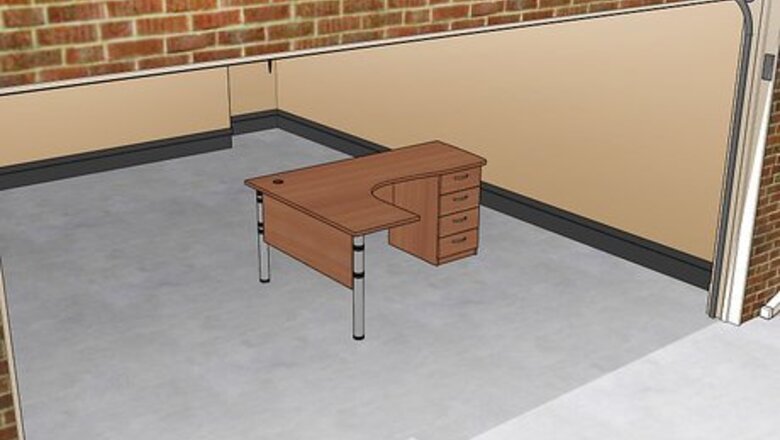
views
- Fill in chipped areas with wood filler and smooth it down with a putty knife. Then, wipe down the furniture with an ammonia-based cleaner.
- Sand your furniture with 220-grit sandpaper using an orbital sander. Wipe up the dust with a damp cloth then apply a thin, even coat of primer.
- Apply a thin, even coat of paint once the primer is dry. Wait for the paint to dry then seal it with a thin layer of clear varnish.
Organizing Your Workspace
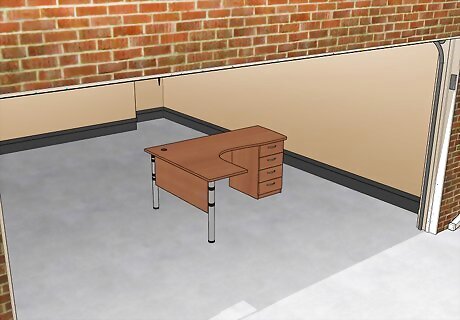
Move small projects outside. Sanding and painting are dirty jobs that create lots of dust and fumes. For painting projects that are small and easy to move, transfer them to an outdoor location where you can work. A garage or shed is also a great place to work if the weather won't allow you to paint outside.

Ventilate the room. When you have to work inside, protect yourself from fumes by opening windows and doors to let fresh air in. You should also open vents to let the fumes escape, and turn on ceiling or stand-up fans to keep fresh air circulating.
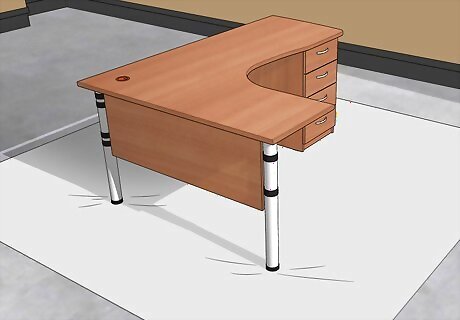
Cover the surrounding area. Protect the floor and the area around your workspace by laying down a drop cloth or large piece of plastic sheeting. If the object you're painting is too large to move, arrange the drop cloth on the floor around it and secure the sheet in place with painter's tape.

Remove any hardware. Veneer is most often found on furniture and interior decoration items, and these pieces sometimes have hardware like handles, hinges, and brackets. To protect these items from paint, remove them before you start the project. Most hardware can be removed with a screwdriver. After you remove the hardware and screws, store them together somewhere safe where they won't get lost or forgotten.

Tape adjacent areas you don't want painted. Some veneer surfaces are attached or adjacent to other surfaces that you may not want to paint. For instance, if you're painting a desk but don't want to paint the legs, you should protect the legs. To cover small areas, use painter's tape to seal the area. For larger areas, cover the surface with plastic and tape the plastic in place.
Repairing and Cleaning the Surface
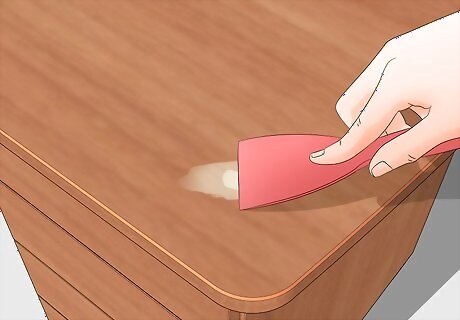
Fix marks and chips. Before you paint the veneer, you have to fill in any areas where the veneer has been chipped, gouged, or dented. Remove any loose chunks of veneer and sand down the edges around each hole. Fill each hole with wood filler, and then smooth it out with a putty knife. Make sure the hole is completely filled in with putty. Let the putty dry completely before proceeding. Follow the manufacturer's directions regarding drying time. Depending on the depth of the holes, drying time could take anywhere from a few minutes to several hours.

Clean the surface with degreaser. Paint won't properly stick to a surface that's covered in dirt, grease, oil, or grime. To ensure the paint has a clean surface, wipe the area with a degreasing cleaner, such as ammonia-based cleaners, denatured alcohol, or ½ cup (4 ounces) of trisodium phosphate mixed with ½ gallon (1.9 L) of water. Use a clean sponge or non-abrasive scrubbing pad to scrub the veneer surface with the degreaser. After cleaning, wipe the area down with a clean damp cloth to remove leftover degreaser. Let the surface dry completely.
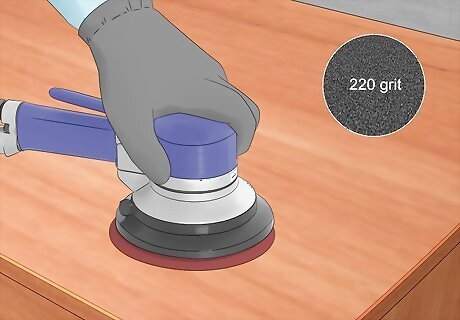
Sand the surface. Outfit an orbital sander with 220-grit sandpaper. Sand the veneer to smooth out the wood filler, even out the surface, and gently scratch the veneer. This will give the primer something to stick to. You can use a sanding block to sand small areas, but an orbital sander will make the job go much faster. Use a sanding block to reach crevices and hard-to-reach areas.
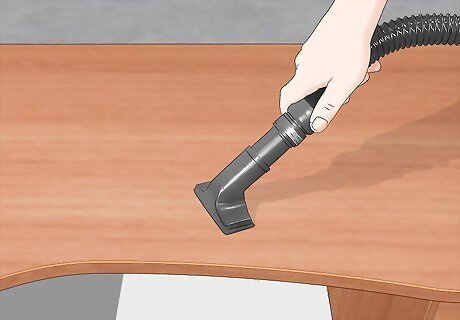
Vacuum and dust. Before you start painting, it's important to remove all traces of dust and particulates that were created by the sanding. Vacuum the piece and the surrounding area to remove excess dust, and then wipe the piece down with a slightly damp cloth. Give the surface some time to dry before priming.
Priming and Painting

Choose the right paint and primer. Because veneer is wood, you have lots of options when it comes to paint types. Typically, you'll start with a primer that matches the paint type, then paint the surface, and then finish with a protective clear coat, varnish, or sealant. Popular paint types for wood include oil-based enamel paints, water-based enamel paints, chalk paint, milk paint, hi-gloss enamel, stains and varnish, and acrylic paint.

Apply primer. Stir your primer and fill the reservoir in a paint tray. Start by using a brush to prime nooks, edges, corners, and cracks. Then, saturate a roller with primer and roll off the excess on the tray. Apply a thin and even coat of primer to the rest of the veneer surface. Primer provided a better adhesion of paint to the surface. Without it, your paint can prematurely peel. Once the primer has been applied, let it dry for at least three hours before applying your first coat of paint. Check the manufacturer's instructions for exact drying time.

Paint the surface. Once the primer has had time to dry, you can apply the first coat of paint. Stir the paint and fill the reservoir of a clean paint tray. Use a clean brush to paint inside cracks, get into corners, and paint edges. Switch to a roller to paint the rest of the veneer. Apply a thin and even coat of paint to the entire surface. Once the first coat of paint has been applied, let it dry before deciding whether you have to paint a second coat. If the surface looks pretty good with one coat of paint, you may still want to apply a very light second coat, just to fill in any little gaps or missing spaces. If a second coat is required, follow the manufacturer's instructions for drying time between coats. Depending on the type of paint, you may have to wait anywhere from two to 48 hours between coat applications.
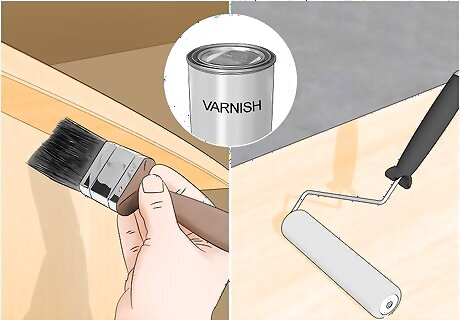
Apply a varnish to seal and protect the paint. When the final coat of paint has dried, use a clear coat, varnish, or sealant to protect the painted veneer surface. Fill a clean paint tray with clear coat. Use a brush to access cracks and corners. Use a roller or foam brush to apply a thin and even layer of clear coat to the rest of the surface. Varnish or clear coat is especially important with furniture that gets used often, such as desks, dressers, and tables.

Remove tape after the final coat. To remove the tape, pick off an edge with your fingernail. Pull the tape toward you at a 45-degree angle to the ground. Use a razor or knife to cut away any paint that's stuck to the tape before removing the tape. It's important to remove the painter's tape when the project is still wet. Otherwise, paint may dry to the tape and peel off with the tape, ruining your project.

Let the piece dry and cure. Your paint may be dry within a few hours, but it could take a couple weeks to cure properly. Curing is the hardening and strengthening process, and you don't want to put your painted veneer into heavy use until the paint has had time to fully cure. Curing time may take anywhere from a week to 30 days. Check the manufacturer's instructions for the complete curing time of the paint you chose.

Reinstall the hardware. After the paint has had time to cure, use a screwdriver to reaffix the hardware that you removed before painting. Once the hardware has been reinstalled, you can return the piece to its original place and use it again as normal.



















Comments
0 comment